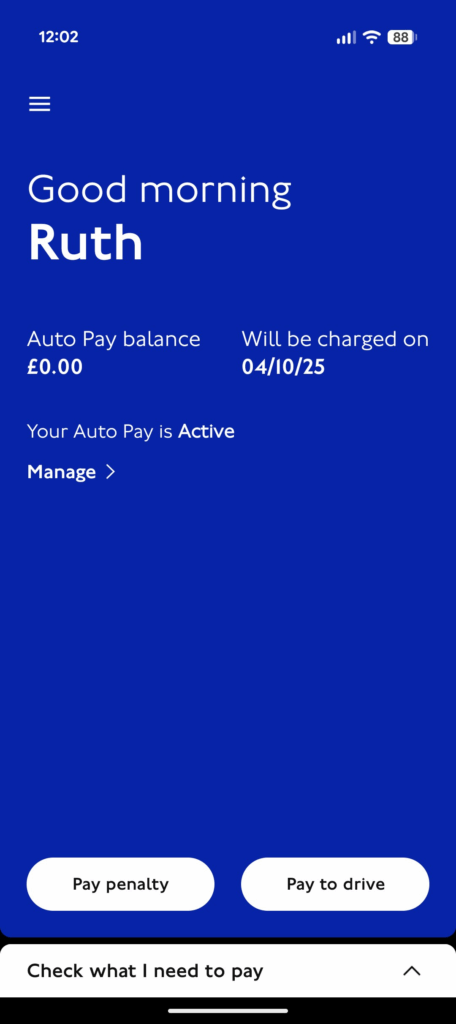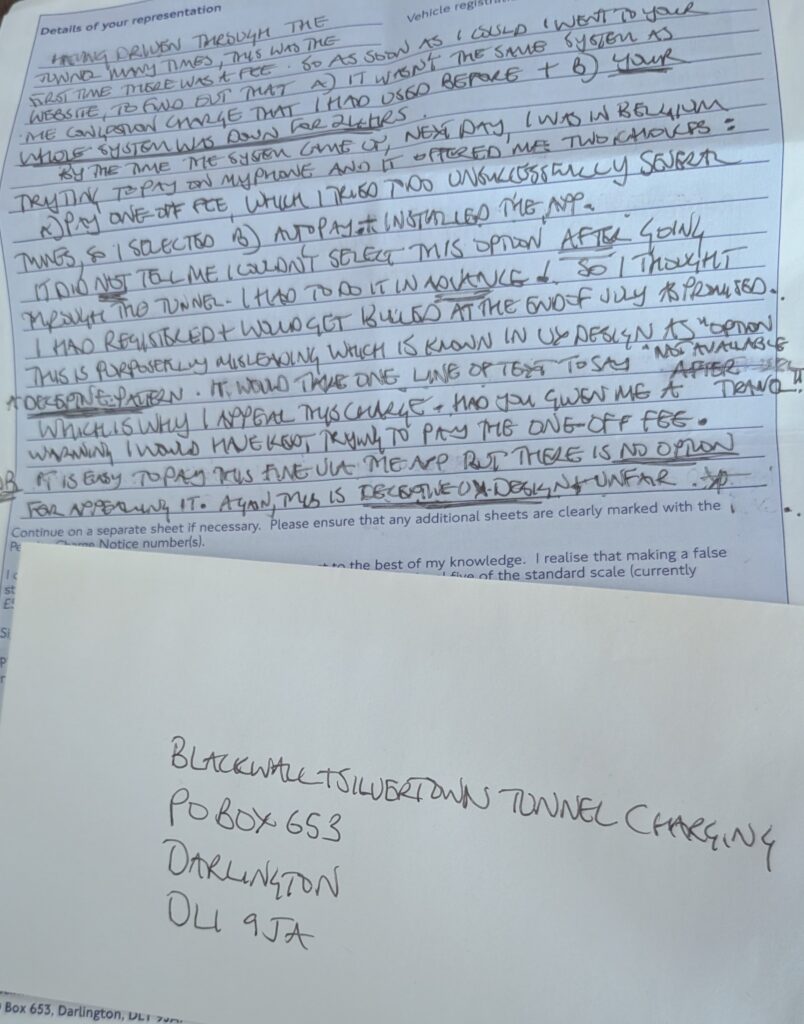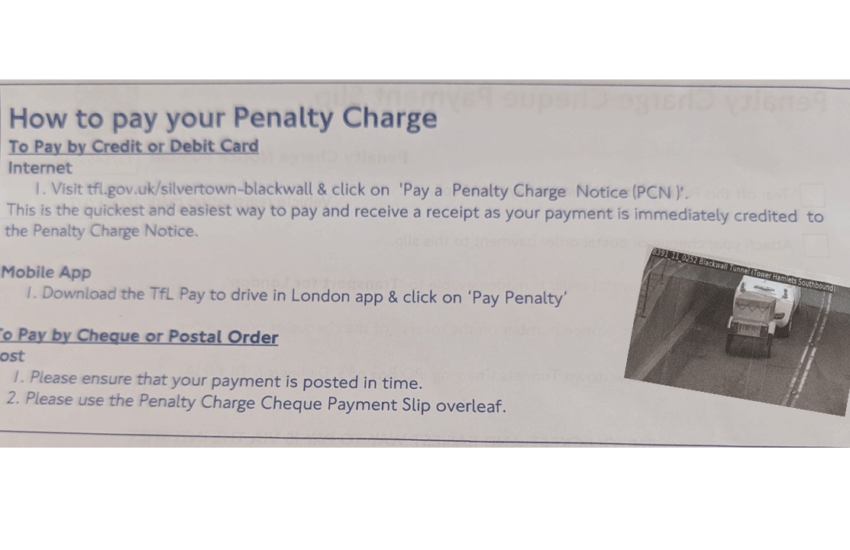This summer, as my family and I were going on holiday, we had to go through the Blackwall Tunnel in my little car.
It had been a while since I’d been down there so I hadn’t realised that they had already started charging for everyone to go through. Whenever I do pass through other tolls in London, such as the Dart Charge, over the Dartford Bridge, or the Congestion Charge (CC), as soon as I can I log in, pay the toll, and all is good.
This time, I saw the signs and as my husband was driving, I logged in straight away to pay it. I tried about five times, but each time I got different messages, until I finally got the message that it was down for 24 hours for maintenance work. So, I put a note in my calendar to check back.
The following evening sitting outside my tent in Belgium, I logged in to pay the bill as I know from experience if you don’t pay straight away you can end up with a fine. One time I just clipped the edge of a CC street near Old St. I’d gone to the Post Office Sorting Office to pick up a package and I’d been directed down a one-way system that went into half a street marked with the CC signs before turning left. I thought to myself that they could surely not charge me for a half-street they have made part of a one-way system. But, they did, £65 for picking up a package and being directed down a one-way system through the congestion charge.
Hoping to avoid any fines, I logged into the special Blackwall and Silvertown Tunnels’ webpage, and was given a choice:
- Pay £4.00 for the one off toll-fee.
- Sign up for autopay £1.50 by giving it my credit card and then it would automatically calculate how much I owed at the end of each month.
I tried several times to pay the £4.00 and for some reason or other it didn’t work. Desperate not to spend the whole evening on it, I signed up for Autopay so that I’d paid the toll and it would save me money. Then, if we ended up going home that way, I wouldn’t have to do this fiddling all again. Brilliant, I thought.
Three weeks later, I got a Penalty Charge Notice (PCN) of £90 from TfL for unauthorised entry into the Blackwall Tunnel. It was a four-page printed letter with pictures of my transgression that came through the post accompanied by a separate detailed leaflet advising me not to ignore the PCN. Complete with the warning that I had to pay within 14 days otherwise it would go up to £180, and then in another 14 days to £270.
The transgression occurred on the 20/7/25. I was apparently issued with the fine on 27/7/25 and I actually opened the fine in August when I got home. So, I had seven days in which to pay the fine.
I immediately went to the website to try and pay this fine, and to check if the other fee had been taken but the website is all over the place and I have about five accounts with TfL:
- Two with Oyster as their sites are so bad. Five years ago, I just couldn’t link my ancient Oyster card to the Oyster account I had had to create when I wanted to do auto top-up and add a bank card. When I rang their helpline, the woman had advised me to just top up my Oyster card at the machines to ‘save myself the hassle’. The auto top-up was supposed to do that but no! I would have to create a new account and pay a fee to replace my old obsolete Oyster card with a new one. So, I was forced to create a new account, add my credit card to it and use my credit card instead of my old Oyster card to zap on and off public transport.
- Another account with the Zip travel cards for my teenagers, with a different email as they didn’t allow me to use the email I had for the account above.
- One for the congestion charge, but it didn’t seem to remember it with the either of the emails above when I was trying to log into the website nor any of the user ID numbers I had stored.
- And apparently a new one for the Auto Pay Blackwall Tunnel.
It was a big mess and I had a fine to pay otherwise TfL were coming to get me.
So, I downloaded the TfL Drive app so that I could enter my car details and check that I wasn’t going to be fined for coming back the other way through the Blackwall Tunnel on our way home. It was the only way to find out this information as the website couldn’t call up this information.
Paying versus appealing a PCN
The app was a bit of a faff but once installed it is straightforward enough and looks like a deceptively clean design but alas, it isn’t very sensible. Here’s a screenshot.

The burger menu on the left-hand side has the options:
- Check what I need to pay (which is a calculator that uses your vehicle+postcode+or your location on a map)
- Manage Auto Pay (add remove vehicles/cards and has financial and vehicle history)
- Vehicles (your registered vehicles seems redundant since you’ve got all that under manage auto pay)
- Payments (again seems redundant since it’s on the ‘Welcome’ screen)
- Discounts (no description at all of what they are)
At the bottom, there are two buttons Pay Penalty and Pay to drive.
Pay Penalty is for if you have a PCN and Pay to drive is if you want to add another car.
I looked all over the app to find an Appeal Penalty which for me should have been under Pay Penalty, but there was absolutely nothing no button or anything. So, I logged back into the website to find the Appeal Penalty section or page there. Surprise, surprise there is absolutely no way of appealing a penalty online.
Deceptive Patterns
This is very bad and is known as a Deceptive Pattern. Some people call it Dark UX or Dark Patterns but the correct and most appropriate term for it is a deceptive pattern.
As you can see there is no easy way of appealing a PCN so people won’t do it. There are many other types of deceptive patterns from companies putting extra things in your shopping basket, such as a warranty or extra batteries for your new purchase, or flashing up messages to tell you if you don’t immediately buy this flight/ticket/course, the spaces will run out.
The TfL is guilty of two:
- Offering me the option of Autopay without telling me that I cannot register for it after I have been through the tunnel.
- Not letting me appeal online or via the app. I have to write to them on a piece of paper and post it to a PO BOX in Darlington, as we will discuss in more detail below:
Appealing like it’s 1989
Baffled, I went back to my physical colour coded letter as they like their blue boxes and red headings and saw that I could appeal on the second page. I had to physically by hand, write my reasons for appealing this PCN and, then go to the Post Office, queue up and buy a stamp (£1.70) and send it to a PO BOX in Darlington like it was 1989 and the WWW had yet to be invented.
However, since it was going to hopefully get me £90 back it was worth the effort, like putting a flutter on for £1.50, so that is what I did. As you can see my handwriting is appalling these days so I wrote in block capitals otherwise they wouldn’t have understood me:

Basically in it I say that:
a) their website was down, and
b) after much hunting around their website to read all of their small print, I discovered that I could not register for autopay after I have gone through the tunnel, I could only register beforehand and that this is a deceptive pattern too.
I explained that all it would have taken was a bit of extra text in brackets. It’s not rocket science to clarify the two options:
Redesign to correct Tfl’s deceptive UX pattern
1) Pay £4.00 (one off toll-fee payable anytime).
2) Sign up for autopay £1.50 (must be done prior to journey).
Many people like me, use these tunnels and systems so infrequently, and doing a whole thing via website is not good UX. I am sitting in a car going down a motorway on a mobile phone trying to read all that text on a website on a small screen to pay a toll, and that’s if the site is not down ‘for maintenance’.
And, that’s the only way to do it, so if you don’t have a smartphone and an good internet connection: You have had it! Social exclusion or what? This app looks like it was designed for business people with a fleet of cars and vans who use these tunnels a lot.
The little people going on holiday or who live in the East End don’t count and have to pay to cross the river, unlike the rich of Chelsea who don’t have any tolls on their Thames. The technology reflects the reality and the reality is just the same old story of no one really cares, we pay lip-service to community, equity and, inclusivity but we don’t really do much to make sure that happens.
In my appeal, I went on to explain that on top of being misled by AutoPay, I cannot appeal online, I can pay my PCN online but not appeal. I have to physically log out, write a letter to someone and then post it to appeal. This is a deceptive pattern and in this day and age a company as big as TfL should just not be doing it.
Whether intentional or not, the idea that we can instantly pay but not instantly appeal and have to write letters to Darlington, means that the less than tenacious amongst us might put just not do it. And, given the threatening nature of the letters with £90 then £180, then £270, we feel we have to pay and that we think there is no point appealing. If the appeal gets rejected you can end up with an enormous fine and a day in court.
I appealed but I still paid the fine first. It’s all a bit dishonest, a bit deceptive. Hence, it’s name: a deceptive pattern. And, the reason it’s called a pattern is because it’s really, really common online!
Three weeks later, I got a letter through the post saying they have cancelled my PCN. Theoretically great, but when I looked on the app, they had not reimbursed me £90, so I had to write them another letter.
Again, because there is no other way of getting in touch with them, I had to write a letter replying to the one that notified me that they had cancelled my PCN saying Dear Mr X, Contracts and Operations Manager, and sign it Yours Sincerely.. with my name, address, cancelled PCN number, car registration, and a copy of the receipt with the number, and post it back to the PO Box again saying:
Please, Sir can I have my money back?
Me to the TfL Contracts and Operations Manager who owes me £90 for his deceptive UX design
I’ve even said just send me a cheque, I’m not fussy since they are operating circa 1989.
This is not how an automatic system should work.
Technical debt
Now, I tend to give designers the benefit of the doubt and don’t think automatically that they are out to fleece me of my cash. Instead, I assume that an organisation as huge as TfL and their rickety systems, rather like the government and the NHS, all have countless systems which alas do not communicate with each other as demonstrated above.
I recently attended a meeting in which the head of IT strategy of a world-leading hospital said that two software systems couldn’t communicate with each other, it just couldn’t be done. They didn’t even say: Though not to worry, someone is working on it, like going to Mars, curing cancer, (or the laughable jobs using machine learning and it’s massive ice-cap melting data centres to solve climate change) and so on. No, it just can’t be done. End of conversation. Be quiet!
Often these people are not trained in IT, so to them it can’t be done, it would be so enormous a task, but, really it isn’t. Writing an interface between two pieces of software can most certainly be done. I could do it for them. Information exchange is the most fundamental of all software activities. It can be done securely and should be done quickly. However, ignorance and bad choices aside, the reason ‘it can’t be done’, is often the result of technical debt.
Technical debt is a term used in software development to describe the cost of maintaining, or in this case, choosing a proprietary system solution for expedient reasons. You may be solving one problem without taking in the rest of the organisation within in which the software has to sit. It may have been cheaper, or it may have been hacked up in a hurry for a deadline, or a presentation. On ‘Day 2’ everyone is going to go back and sort that out. Though, they never do. Eventually this low quality software may increase future costs if left unresolved, as is the case with the crap IT of this hospital.
I am guessing by now that TfL has a huge technical debt with all of their systems that don’t quite work, and different departments which process different problems in a big complex socio-technical system such as a transport network in an enormous city.
In an ideal world, as a London resident using the TfL infrastructure daily, I should be able to log into one TfL account for public transport or driving or parking, etc. As it is, it’s all piece-meal with local councils and TfL intervention and third-party apps managing council parking and TfL commissioning special non-communicating apps for paying tolls and so on.
When I log into my insurance company, I have one app with different sections for Pets, Car and, Home.
Given that TfL is private/public/contracted out, I shouldn’t think any of these systems will ever talk to each other. And, as we automate our whole lives, and all that life admin we are forced to do online is only going to get worse as Day 2 never comes.
With the latest hype around AI, not only do we have a Day 2 that never comes, we will have some generated text giving us an approximation of what they think the answer could be, at least though we can hope that it will read all the dodgy webpages and won’t miss the small print. That is, of course, unless these pages aren’t very popular, which they aren’t, so won’t even cross the algorithms path.
Alas, deceptive patterns are here to stay as we all remain in Day one. And if you think AI can sort out the technical debt and the deceptive patterns, think again. It will end up yet another system that doesn’t quite work, introduced by people who don’t know any better.
[Part 2 – The UX of TfL’s Blackwall Tunnel: The saga continues (2) ]






